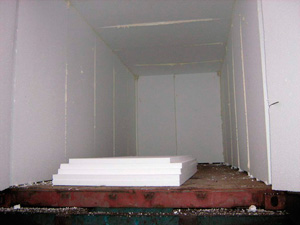Heat Insulation Inside Of Containers

In winter time during transportation of cargoes in containers, which are sensitive to ambient temperature (for example, fruits and vegetables, liquids and so on), it is recommended to install heat insulation inside of the container in order to maintain stable temperature inside and escape spoilage of Goods. During installation of heat insulation inside of the container, environmentally friendly materials are used only.
Types of heat insulation:
- Single layer of heat insulation. Foam plastic, gluing, installation foam, foamed sealant and liquid nails are used as single layer of heat insulation more often. It is possible to install heat insulation which made of special insulating material and veneer.
- Double layer of heat insulation. Two layers of foam plastic with gluing are used for this purpose. Layers of foam plastic are put overlapping for creating additional heat, special film is put between two layers of foam plastic. Double heat insulation normalizes temperature inside of the container better and protects the cargo from sharp temperature difference.
Choice of type depends on Goods and season of transportation. We can install heat insulation inside of the container in order to maintain necessary temperature conditions and preserve the quality of Goods during transportation. We also can install heat insulation for individual cargo package. The necessity of installation heat insulation and type of it should be indicated in your order, which you place with us for transportation, also you should consult with managers who are in charge of delivery.
Please also read other articles in this section:
THE MOST POPULAR TERMS OF DELIVERY — EXW AND FOB
EXW — Ex Works (named place of delivery) means that a seller’s only responsibility is to make the goods available at his premises (works or factory). The buyer bears the full cost and risk involved in bringing the goods from there to the desired destination.
FOB — Free on Board (named port of shipment) means that the goods are placed on board the ship by the seller at a port of shipment named in the sales contract. The seller must clear the goods for export. The risk of loss of or damage to the goods is transferred from the seller to the buyer when the goods pass the ship’s rail.



